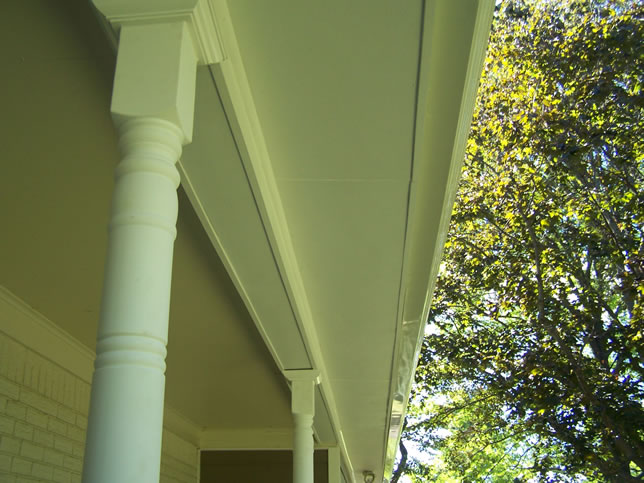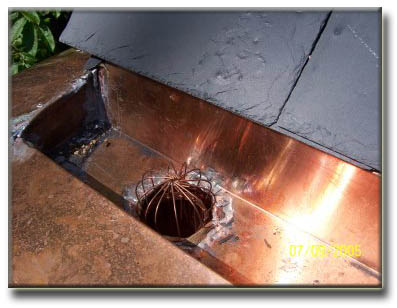With all the ‘K’ Style that is sold as “seamless,” run off a coil and job formed in many colors, it seems like the best thing since sliced bread. Truth be known, the miters are seamed, the end caps are seamed and they always leak. The gutter is mounted onto the fascia at the eave and tight up to the roof. The gutters are aluminum and the expansion and contraction rates are fairly significant, while being fastened tight with no provision for thermal movement. These gutters are installed outside of the roof plane but become almost integral, when adverse weather hits.
 'K'Style mounted tight with hidden vents
'K'Style mounted tight with hidden ventsAll sorts of gutter covers are sold, every one of which are expensive and inhibit or eliminate the function of the gutter. Water runs over the gutter when heavy rain accumulates on the roof and washes over the gutter cover and onto the ground. In the belly of the gutter is a layer of scum that builds and breaks down and dries in times of drought. This scum layer, after about 5 years needs to be cleaned out. Many of these gutter covers make it impossible to clean the gunk out of the bottom of the gutter. When the build-up becomes thicker than ¼” dry weather causes it to crack when the gutter flexes and the scum is hard. The broken material lining the bottom of the gutter will wash to the outlet when a good rain comes and the gutter will clog. Five years is about the life expectancy of the gutter cover systems’ so called “never clean your gutters again” claim.
If your building is a candidate, spend the money on copper half round gutters. Go to a 6” with 4” spouts. A 4” spout is harder to clog. If you have an under ground system, a basket strainer can be installed at the outlet.
 (Basket Strainer in a box gutter)
(Basket Strainer in a box gutter)Half round gutters are self cleaning in many cases, but they have to be checked in areas where heavy fallen foliage accumulates on the roof. Cleaning is a snap as the gutter is open without hangers blocking the way to clean them. The copper prohibits the scum layer as microbial activity if killed by the copper. The copper is allowed to flex with the hanger systems. The joints are soldered tight (do not purchase the new ornate rubber sealed copper gutters – stay with old school).
For the best property of half round gutter, look at the way they mount. They hang and are held away from the fascia and under the roof. When a major snow even comes or when the gutters may be clogged for any reason, the water is allowed to flow out and not into the eave of the building. Solid cornice is always the way to go and (silly) aluminum capping should never be considered. The solid cornice with the proper ventilation will allow a solid mount for the half round (if fascia mounts are used). The space between the gutter and the roof and fascia allows for ice blockages to melt and flow away. (Note: In the photos there are hidden intake vents on the edge of the roof)
The old ways are the best ways. It just makes sense. Another forgotten is the leader head. These were installed right below the gutter. Many “experts” think they are just for aesthetics, but they have purpose. They allow air into the spout so that water will flow and when ice is present, the added room for ice melting and movement keeps the spout from splitting from solid ice. These systems of old cannot be beat by anything in the modern arena. Adding more to the equation like gutter immovable covers will just mean more trouble later.
Galvanized is the most formidable and lasting, but the seams can be a maintenance problem. Aluminum is weak and dents easily when a ladder is put upon it. Copper lends a perception of lasting value and the changing patina keeps the look interesting. The protective patina usually takes ten years to develop. Copper that is shiny has a problem and is being degraded by another material of chemical or galvanic reaction. More on all of this can be found on our website.
Shiny Copper indicates erosion
Thermal Movement Properties of commonly used metals
[ add comment ] ( 657 views ) | [ 0 trackbacks ] | permalink |




 ( 3 / 349 )
( 3 / 349 )
 Random Entry
Random Entry




